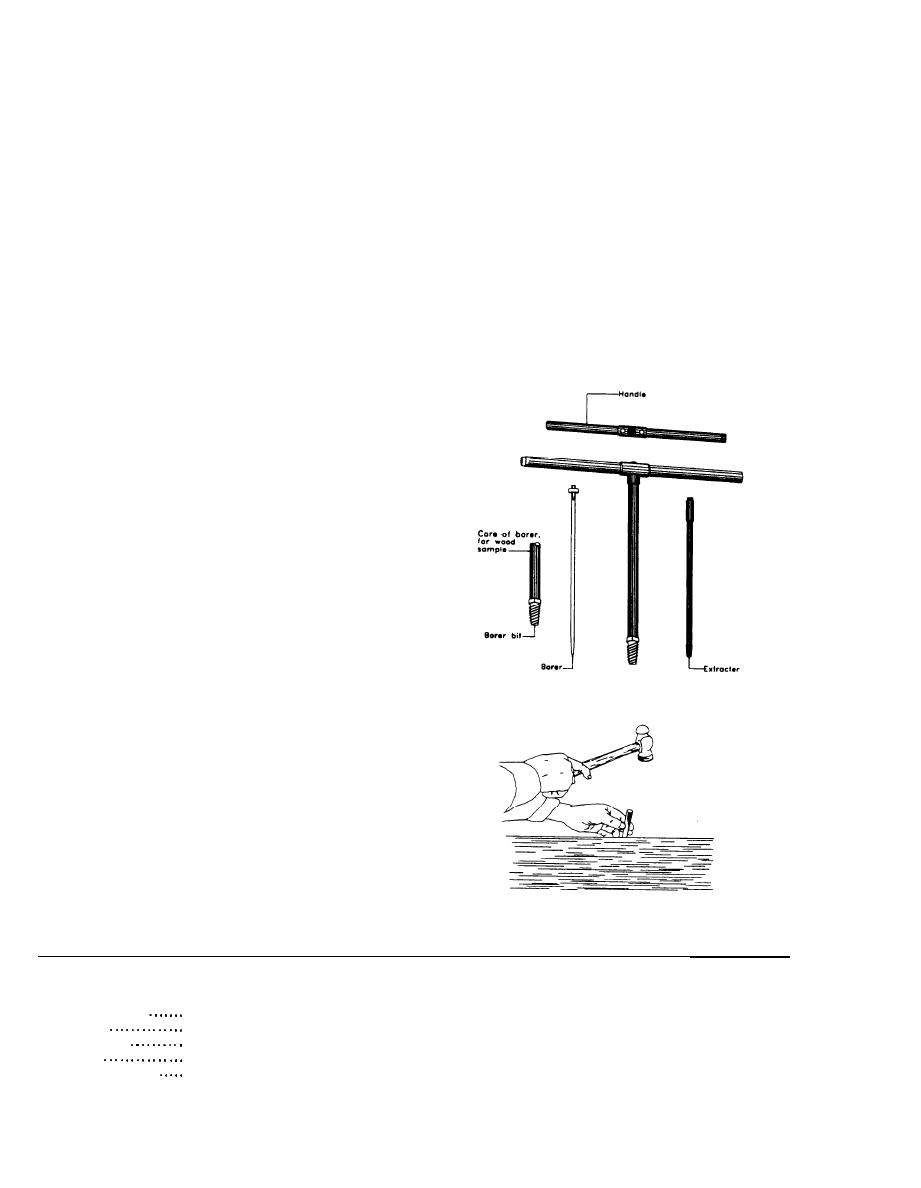

Custom Search
|
|

|
||
 TM 5-684/NAVFAC MO-200/AFJMAN 32-1082
points for boring to determine the extent of any
soft and moist, but not decayed, if preservative is
internal decay above ground.
present and the wood fibers are strong.
b. Test boring. Whenever there is reason to sus-
__
pect possible internal decay above or below the
the preservative will be plainly visible, especially if
ground line, the pole should be bored with an incre-
it is creosote. In good original treatment, it extends
ment borer as shown in figure 4-5. It is usually not
the depth of the sapwood (table 4-l shows sapwood
necessary in cedar poles due to their decay resistant
thickness). Some borings will show a heavy absorp-
tion of preservative, while in others it may appear
heartwood.
in bands, giving the core a striped appearance. (An-
(1) Increment borer. An increment borer con-
nual growth rings comprise hard dark summerwood
sists of three parts-the borer, the extractor, and
and softer, sometimes spongy, springwood. `Usually
the handle, which also serves as a receptacle for the
the summerwood absorbs more preservative in the
other two parts when not in use. The tool is made of
timber species that are suitable for poles). In poles
the highest-quality steel to withstand the force ap-
treated with pentachlorophenol (penta) solution,
plied, though the borer has a cutting edge which
the oil carrier may not be visible, even though the
must be protected from abuse. When boring below
penta itself is present in sufficient amount.
the ground line, the pole surface at the spot bored
should be thoroughly cleaned of soil and grit by
shaving or brushing. Bore toward the center of the
pole, applying steady pressure to start, and in as
nearly a horizontal line as possible. If any slant is
necessary, it should always be upward to prevent
any later water accumulation. The core is removed
with the extractor by backing the borer a half turn
after the extractor is shoved in, so as to break off
the core before withdrawal.
(2) Plugging bored holes. All bored holes must
be plugged by hammering in a tight-fitting treated
wood plug as shown in figure 4-6, regardless of
whether the pole needs to be replaced. Habitually
and promptly drive a plug in each hole before boring
another or before proceeding with other work. Oth-
erwise, a bored hole may be overlooked, opening the
way for future internal decay. The plugs, made of
doweling, may be obtained from most pole suppli-
Figure 4-5. The increment borer
ers. Those pointed on one end are preferable but not
required. They should be 3 or 4 inches (80 to 100
millimeters) long with a diameter l/32 inch (0.8
millimeters) larger than the hole bored to provide a
snug fit. The borer, an adequate supply of plugs,
and a hammer should be kept together as a kit.
(3) Evaluating test borings. The extracted core
should be carefully examined for wood integrity or
evidence of decay, extent of any decay pocket, and
the amount of original preservative in the wood.
Decay will be evidenced by crumbly wood in part of
the core. If a pole is badly decayed, a core may not
be withdrawn intact. Borings may sometimes be
Figure 4-6. Sealing a test hole with a treated wooden plug
Table 4-l. Sapwood thickness in poles
Species
Sapwood thickness
Sapwood thickness
Natural heartwood
(inches)
(millimeters)
decay resistance
to
1.25
Western red cedar
0.5
13
to
32
High
0.75
Douglas fir
to
2.5
19
64
Moderate
to
0.5
Western larch
to
1.5
13
38
Moderate
to
0.75
Jack pine.
to
2.0
19
to
51
Moderate
2.0
Red (Norway) pine..
to
4.0
51
102
to
Moderate
4-8
|
 
|
|
 |
||